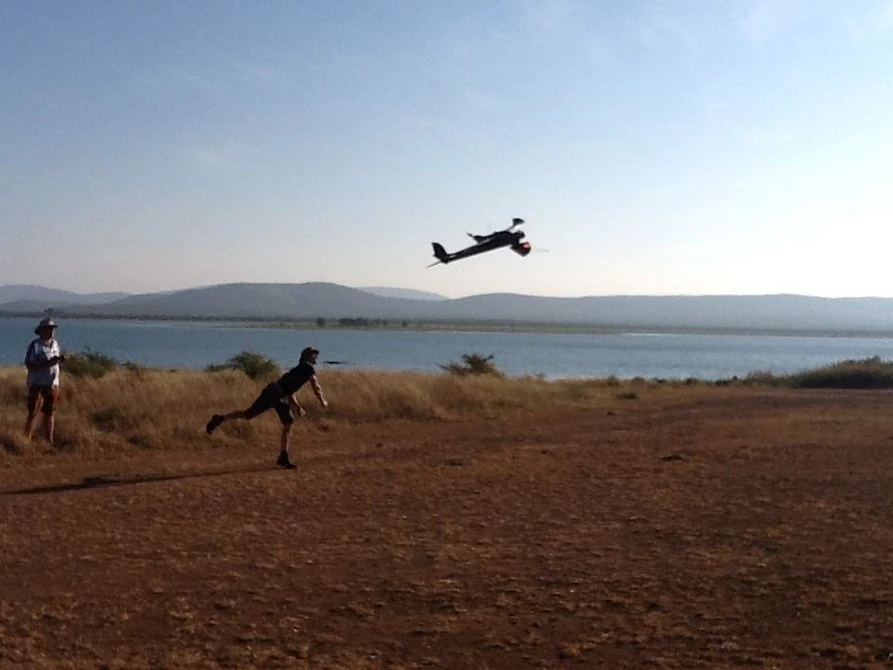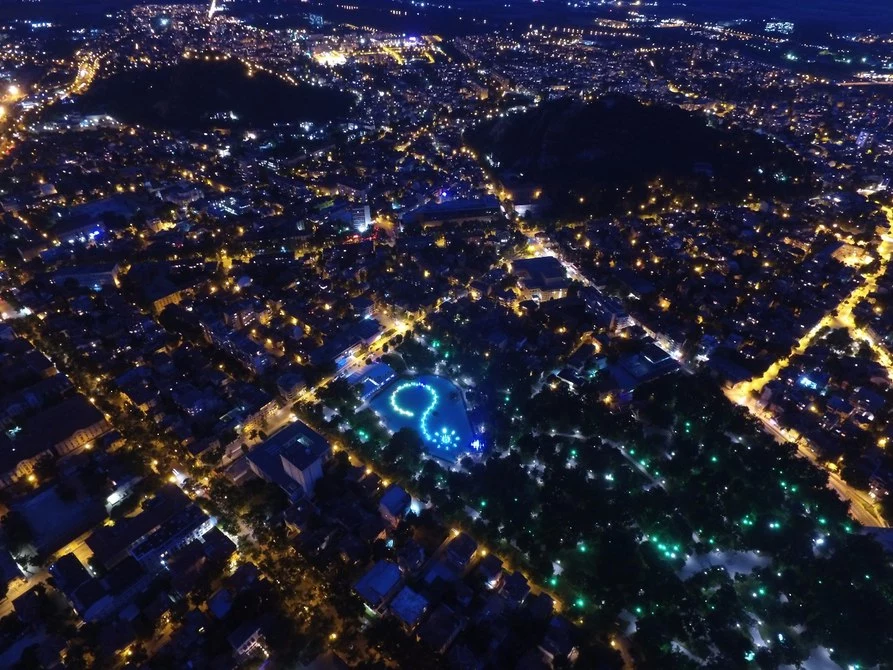Drones have continued to capture our imagination in remarkable ways throughout 2015. Despite the thick layers of bureaucracy that outlaw commercial use in much of the world, fresh ideas itching to put the technology to use constantly come to the fore. Let's cast our eye over some of the more promising to emerge this year; a diverse list that includes everything from drones that deliver medical supplies to drones that can build bridges all by themselves.
Fighting fire with fire-starting drones

Controlled burning is a measure often taken by land management and conservation teams, as it can help deter invasive species and mitigate the risk of larger, more damaging blazes in the future. But getting them started by hand or all-terrain vehicles carries some risk.
Researchers at the University of Nebraska-Lincoln are working on a safer and cheaper approach, starting these fires form the sky by way of drones. The vehicles under development carry a basket full of ping-pong like balls full of potassium permanganate powder. Just before being shot at a target area, the drone injects each ball with liquid glycol causing it to burst into flames soon after hitting the ground.
Drones that maintain cities

For every gaping pothole, blown street lamp and busted power line, a pair of human hands needs to tend to the problem. The University of Leeds has embarked on a £4.2 million (US$6.4 million) project aimed at ushering in the era of self-repairing cities. The thinking is that fleets of flying robots will detect deterioration in infrastructure early on, preventing them from evolving into larger repair jobs that would lead to larger inconveniences like major roadworks.
The venture is in its very early stages, with the team planning to begin actual testing of the drones next year, but it has broken it down into three areas. This includes drones that perch on powerlines like birds and repair busted street lights, drones that watch over the streets to patch up potholes and robots that function independently to carry out inspections and repairs on live utility pipes.
Fast-moving drones that navigate trees on their own

Perhaps the most common objection to drones, particularly the autonomous variety, is how we can prevent them from ramming into things. Some progress has been made toward fitting drones with obstacle avoidance systems, but the technology have been very limited, only allowing the drones to move at very slow speeds – around 8 or 10 km/h (5 or 6 mph).
But a recent breakthrough by researchers at MIT saw an obstacle avoiding drone autonomously weave its way through trees at up to 48 km/h (30 mph). The advance relates to the volume of images the drones must process as it moves through its environment. The new approach basically streamlines the computational algorithms required for the drone to map its surroundings and could be the first step toward obstacle-avoiding drones that serve a real practical purpose.
Drones that build walkable rope bridges

The work underway at ETH Zürich's Institute for Dynamic Systems and Control is well worth keeping an eye on if you're interesting in the role drones might play in construction (check out our feature for more on that). This team of roboticists is investigating how flying robots can be programmed to autonomously build tensile structures.
In September the made a significant breakthrough. A fleet of quadcopters equipped with motorized spools of light-but-strong rope moved autonomously between two scaffolds, weaving a series of knots, links and braids across nine segments. The result? A walkable rope bridge that can support the weight of an adult human as they walk across it.
Drones that drop off critical medical supplies

Perhaps no potential application for the technology creates as much buzz as the prospect of drone deliveries, due in no small part to Amazon's well-publicized but controversial plans for 30 minute shipments. But those looking to get in on the action in the US have their hands tied, as the wait continues for Federal Aviation Administration (FAA) to revamp the laws around commercial flight.
We did however get a glimpse of what things might look like in July this year, when Australian start-up Flirtey gained a one-off approval from the FAA to deliver medical supplies to a rural area in Wise County, Virginia. The exercise cut the time patients at the annual medical clinic were made to wait for their medication from at least a day to half an hour. Though it was more a proof-of-concept than the beginning of routine drone delivery, it did demonstrate the potential of what could become an infinitely more efficient delivery method.
Showing us the world from stunning new angles

Drones that can shoot photos became a reality well before 2015, but this was the year that any high-level consumer quadcopters carrying anything less than HD camera gear would be left well behind. The end result of this is vehicles that can snap crisp, high-res shots finding their way into more hands than ever before, in turn lifting the standard of drone photography to stunning new heights.
The folks over at Dronestagram are well aware of this. This year they held their second annual drone photography contest and the finalists were nothing short of spectacular. The winning snap above was taken in Maringá, Brazil, capturing the tip of the town's tallest buildings as they poke through a dense cloud.
The fast and furious world of underground drone racing

Earlier this year, Gizmag paid a visit to a derelict warehouse in the suburbs of Melbourne, Australia, where a bunch of drone owners had congregated with custom-built quadcopters and first person view goggles (FPV) in tow. Here, just as other groups do at vacant carparks and forest settings around the world, the drone racers pitted their rides against one another in a unique mix of virtual reality and video gaming bought to life.
The out-of-body sensation felt as the racers zip through obstacles and cameras mounted on the nose of the drone stream back live footage to their googles is said to be quite the experience. And it has catapulted this once underground activity to the fringes of professional sport, with the inaugural US National Championships in July this year giving away US$25,000 in cash prizes.
Bringing aid to the war-torn Syria

For humanitarian groups, getting food and medicine to civilians in need in war-torn Syria is an almost impossible task. But the ravaged city of Aleppo does present some opportunity, at least in the eyes of Uplift Aeronautics, as it sits not all that far from the Turkish border. The startup aims to launch humanitarian drones from inside Turkey that drop packages into Syria containing important supplies such as vitamins, tools for water purification and baby milk.
Watching over Africa's endangered species

Keeping Africa's national parks free of poachers is hugely demanding, resource-intensive task for local rangers. Tusks and horns present an irresistible temptation to hunters, who have little trouble slipping through the porous borders at night time to track down their targets.
But an organization called Air Shepherd is looking to beef up the patrol teams by way of surveillance-oriented drones. Fitted with infrared cameras and GPS, the drones can fly for two hours at a time scanning the area for poachers. In the even that unauthorized persons are on site, the system notifies rangers on the ground who can move in to make an interception.
Dangling US$1 million in prize money for positive drone ideas

Though we tend to focus on the beneficial aspects of the technology here at Gizmag, drones are undoubtedly a controversial topic. To promote the positive uses for the technology, and encourage bright, forward-thinking concepts, the United Arab Emirates launched an international competition designed to attract the best ideas for the technology by offering up US$1 million in prize money.
Among the finalists were drones that fly over reforestation zones and shoot biodegradable seedpods into the ground to boost replantation efforts, drones that scan war-affected regions for landmines and data-capturing drones that would help in development of slums. This year's winning concept was a crash-proof drone designed to fly through confined spaces while protected by a spinning cage.
Uncharted territory
It's going to fascinating to watch this technology continue to evolve and at some point or another, be deployed on a grand scale. As the technical capabilities continue to advance and spark the imaginations of big-picture thinkers aiming to solve real-world problems, we're sure these smart little machines will continue to open up all kinds of possibilities, and we plan on covering them every step of the way.
This list is by no means comprehensive – we've covered many more interesting drone applications in our pages during the year, and no doubt there are many others out there. If you've come across new and innovative ways in which these aircraft are being used, we'd love to hear about them in our comments section below.

























